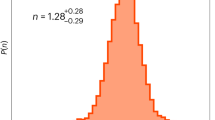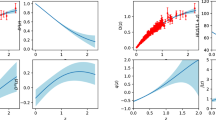Abstract
In this paper, a new approach for studying Hubble diagrams of quasars is introduced. The purpose is to reduce the well-known very large scatter in the diagram. We believe that the scatter is mainly caused by the wide spread of luminosity distribution of quasars. Based on a large number of quasars having been discovered, we introduce a new quantity, the collective apparent magnitude of certain amount of quasars in a corresponding redshift interval, and make a plot of the collective apparent magnitude versus redshift with the data published by Hewitt and Burbidge (1993). The quantity is contributed by individual apparent luminosities as well as the luminosity distribution of quasars. Scatter is expected to be largely reduced in the corresponding diagram, and this is indeed true as shown by the figures. By discussing several possible effects and from the figures, we find that the assumption that redshifts of quasars are distance indicators is confirmed, and the standard cosmological model is supported.
Similar content being viewed by others
References
Boyle, B.J., Fong, R., Shanks, T. and Peterson, B.A.: 1987, Mon. Not. R. Astron. Soc. 227, 717.
Boyle, B.J., Shanks, T. and Peterson, B.A.: 1988, Mon. Not. R. Astron. Soc. 235, 935.
Duari, D., Das Gupla, P. and Narlikar, J.V.: 1992, Astrophys. J. 384, 35.
Fall, S.M. and Pei, Y.C.: 1989, Astrophys. J. 337, 7.
Heisler, J. and Ostriker, J.P.: 1988, Astrophys. J. 332, 543.
Hewitt, A. and Burbidge, G.: 1989, Astrophys. J. Suppl. 69, 1.
Hewitt, A. and Burbidge, G.: 1993, Astrophys. J. Suppl. 87, 451.
Hoyle, F. and Burbidge, G.R.: 1966, Nature 210, 1346.
Matthews, T.A. and Sandage, A.R.: 1963, Astrophys. J. 138, 30.
Narlikar, J.V.: 1986, in: G. Swarup and V.K. Kapahi (eds.), IAU Symp. 119, Quasars, Reidel, Dordrecht, p. 463.
Ostriker, J.P. and Heisler, J.: 1984, Astrophys. J. 278, 1.
Pei, Y.C.: 1995, Astrophys. J. 438, 623.
Scott, D.: 1991, Astron. Astrophys. 242, 1.
Weinberg, S.: 1972, Gravitation and Cosmology: Principles and Applications of the General Theory of Relativity, John Wiley, New York.
Rights and permissions
About this article
Cite this article
Qin, Y., Xie, G., Wang, J. et al. A New Approach for Studying Hubble Diagrams of Quasars. Astrophysics and Space Science 253, 19–26 (1997). https://doi.org/10.1023/A:1000588421897
Issue Date:
DOI: https://doi.org/10.1023/A:1000588421897




